Poster
Contents
| INABIS '98 Home Page | Your Poster Session | Related Symposia & Posters | Plenary Sessions | Exhibitors' Foyer | Personal Itinerary | New Search |
The Modulation of the Soleus Stretch Reflex by Electrical Conditioning Stimuli to the Peroneal and Plantaris Nerves
Contact Person: Michel Ladouceur (mla@smi.auc.dk)
Results
Effect of different conditioning sites
Figure 3 reports the time-course of the inhibition of the soleus stretch reflex by a conditioning stimulus to four different sites. The stimulus applied to the different sites do not seem to condition the SOL stretch reflex identicaly. It can be seen that the common peroneal nerve stimulation provides a greater inhibition that lasts for a longer time then the other sites.
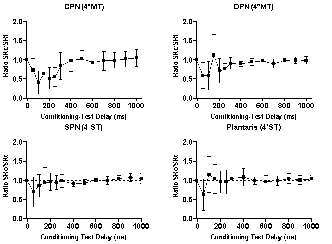 Click
to enlarge
Click
to enlarge
Fig. 3: Time course of the inhibition of the soleus stretch reflex
for the four different conditioning sites. The error lines represent
the standard deviation (CPN: Common Peroneal Nerve; DPN: Deep Peroneal
nerve; SPN; Superficial Peroneal Nerve).
It can be seen from figure 4 that conditioning on the common peroneal nerve was the most effective way to reduce the soleus stretch reflex both for the amplitude and area under the curve of the inhibition. However, there was no statistical difference between the different conditioning sites on the amplitude of the inhibition (F: 2,459; dF: 3; P: 0,0835).
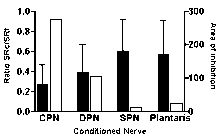 Click
to enlarge
Click
to enlarge
Fig. 4: Amplitude and area under the curve of the inhibition of
the soleus stretch reflex for the four different conditioning sites.
The black bars represent the amplitude whereas the clear bar represent
the area under the curve. The error lines represent the standard deviation
(CPN: Common Peroneal Nerve; DPN: Deep Peroneal nerve; SPN; Superficial
Peroneal Nerve).
Effect of different level of pre-contraction
Figure 5 show the time-course of the inhibition of the soleus stretch reflex by a conditioning stimulus for four different level of pre-contraction of the tricep surae. It can be seen that in the relaxed muscle the SOL stretch reflex is still inhibited one second after the conditioning stimulus to the common peroneal nerve. It can also be seen that even at a very small level of contraction the inhibition caused by a conditioning stimulus to the common peroneal nerve lasts for a much shorther time duration.
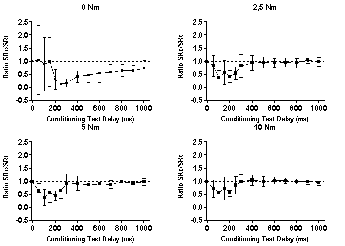 Click
to enlarge
Click
to enlarge
Fig. 5: Time course of the inhibition of the soleus stretch reflex
for the four different pre-contraction level. The error lines
represent the standard deviation.
As seen in figure 6, the amplitude of the inhibition is different between the relaxed and pre-contracted experimental condition. There was a statistical difference between the different level of pre-contraction on the amplitude of the inhibition (F: 10,24; dF: 3; P: 0,0002). A Tukey's post hoc test showed that there was a statistical significant difference between the relaxed condition (0Nm) and all pre-contracted conditions but no differences in between the pre-contracted conditions.
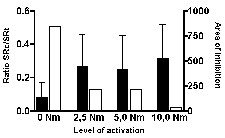 Click
to enlarge
Click
to enlarge
Fig. 6: Amplitude and area under the curve of the inhibition of
the soleus stretch reflex for the four different pre-contraction level.
The black bars represent the amplitude whereas the clear bar represent
the area under the curve. The error lines represent the standard deviation.
Effect of different level of conditioning stimulus intensity
Figure 7 show the time-course of the inhibition of the soleus stretch reflex by a conditioning stimulus for four different level of conditioning stimulus intensity. It can be seen from figure 7 that conditioning on the common peroneal does not have a different time-course for the conditioning stimulus intensity of 2 and more MT.
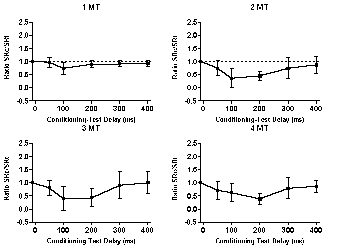 Click
to enlarge
Click
to enlarge
Fig. 7: Time course of the inhibition of the soleus stretch reflex
for the four different level of conditioning stimulus intensity.
The error lines represent the standard deviation.
As seen in figure 8 there was a statistical difference between the different level conditioning stimulus intensity on the amplitude of the inhibition (F: 11,47; dF: 3; P: 0,0001). A Tukey's post hoc test showed that there was a statistical significant difference between the 1 MT condition and all the other conditioning stimuli intensity but no differences in between the 2 and more MT intensity conditions.
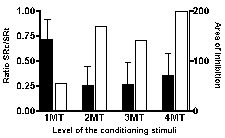 Click
to enlarge
Click
to enlarge
Fig. 8: Amplitude and area under the curve of the inhibition of
the soleus stretch reflex for the four different conditioning stimulus
intensity. The black bars represent the amplitude whereas the clear
bar represent the area under the curve. The error lines represent the standard
deviation.
Effect of the conditioning stimulus on the stretch reflex-stretch velocity relationship
Figure 9 show the grouped (N=8) stretch reflex-stretch velocity relationship with and without a conditioning stimulus. The conditioning stimulus illustrated is 2*MT and the delay used was 100 ms. It can be seen from figure 9 that conditioning on the common peroneal does not have an effect on the slope of the relationship (full line) but seems to change the threshold of the stretch reflex.
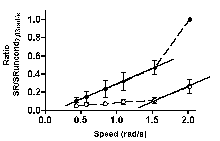 Click
to enlarge
Click
to enlarge
Fig. 9: Stretch-reflex-stretch velocity relationship with and without
a conditioning stimulus. The error lines represent the standard
deviation.
Effect of a block of the common peroneal nerve on the inhibition caused by the conditioning stimulus
Figure 10 shows the changes occuring on the inhibition after a block of the common peroneal nerve distally from the site of stimulation. It can be seen that even after a common peroneal nerve block the inhibition is still present. The diminution in the inhibitory effect could be explained by the diminution in the afferent inflow as seen by a diminution in the sensory evoked potential.
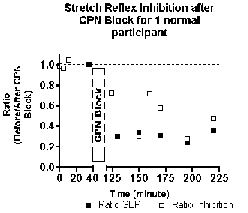 Click
to enlarge
Click
to enlarge
Fig. 10: Effect of a conditioning stimulus after a reversible block
of the common peroneal nerve.
| <= Materials & Methods | RESULTS | Discussion & Conclusion=> |